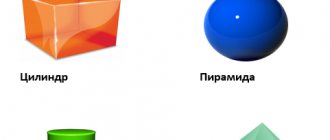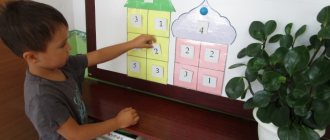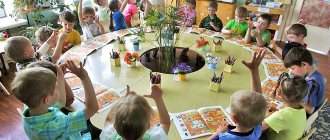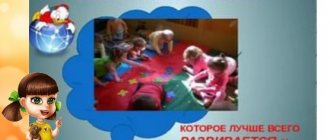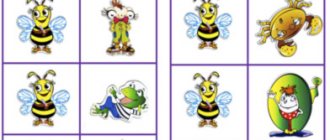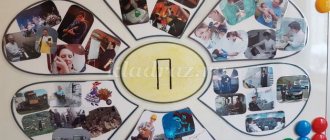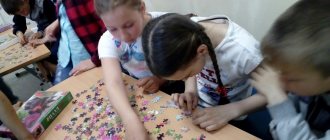Didactic games for preschoolers. Fun facts about mathematics (middle group) on the topic
Didactic games on FEMP
"Mosaic", "Puzzles"
Purpose: develops hand motor skills, attention, logical thinking, perseverance.
"Colors and Shapes"
Goal: helps the child learn basic colors and their shades, basic shapes, as well as such important concepts as “big”, “small”, “more”, “less”.
Lotto "Fun Math"
Goal: develops attention, logical thinking, perseverance, continues to teach counting up to 100, trains visual memory.
Smart domino "subtraction"
Goal: develops hand motor skills, attention, logical thinking, perseverance, trains visual memory, strengthens subtraction skills.
"Children about time"
Purpose: the game introduces children to time concepts (seasons, months, days of the week, parts of the day, hours), develops storytelling skills using pictures.
“Choose by color and shape”
Goal: development of logical and figurative thinking, voluntary and involuntary attention.
"Opposites"
Goal: development of attention, speech, figurative and semantic memory, lays the foundations of logical thinking.
"Fun Logic"
Goal: develops imaginative thinking, analytical perception, develops the ability to visually examine and analyze objects, their verbal description and mental construction.
"Seasons"
Goal: develops memory, observation, creates interest in the world around us.
"Color Geometry"
Goal: consolidates knowledge about geometric shapes and colors, develops attention, perception, and logical thinking.
"Kaleidoscope of figures, colors, activities"
Goal: develops spatial orientation, artistic and creative imagination, intelligence and attention, in a playful way teaches mastery of geometric shapes, the ability to identify one specific color from a variety of colors.
"Solving Examples"
Goal: strengthening counting skills, mastering mathematical operations: addition and subtraction, teaches how to compose and solve problems.
Didactic games for speech development
"My apartment"
Goal: to form children’s knowledge about the characteristic furnishings of the apartment; the game teaches them to choose the right picture with the furnishings for the selected part of the apartment, to develop thinking, intelligence, the ability to explain their actions, and memory.
Lotto “All professions are important”
Goal: develops speech, thinking, speech apparatus, ideas about professions.
“Call it in one word”
Purpose: develops logical thinking, dexterity and speed of thought and action of the player.
"Speech therapy lotto"
Goal: develops phonemic hearing, teaches how to pronounce sounds correctly, studies sound-letter analysis of words, develops attention, memory, and thinking.
"On the Path of Words"
Goal: develops coherent speech, attention, memory, imagination, logical thinking and phonemic hearing in children.
"We will build a house"
Purpose: develops memory, thinking, imagination, to form children’s knowledge about characteristic objects of building material, the game teaches them to choose the right picture.
"The Fourth Wheel"
Goal: develops logical and figurative thinking, speech apparatus.
"Chain of Words"
Goal: develops the ability to detect the location of the first and last sounds in words.
"Let's play"
Purpose: the game develops sensory education, visual perception, forms the development of stable ideas about the shape, color, size of objects, teaches how to establish coincidence and discrepancy.
“I know all professions”
Purpose: introduces professions, trains memory, attention, logical thinking and speech.
"We're playing shop"
Goal: introduces children to items sold in stores, children’s ability to classify items, name groups of items with generalizing words.
Didactic games about the world around us
“Animals and birds: what they say and what they eat”
Goal: develops speech, introduces animals and birds, as well as how they “speak” and what they eat.
"Pets" I
Goal: introduces children to the benefits of pets, their varieties, how they are useful in the household, develops voluntary and involuntary attention, memory, imaginative and logical thinking.
"Hares in the Forest"
Goal: introduces predatory and herbivorous animals, develops logical thinking, memory, and speech.
"Chekhagor"
Purpose: develops attention, logical thinking, dexterity and speed of thought and action of the player.
"Animals and their young"
Goal: introduces animals to central Russia, expands vocabulary, develops memory, teaches correct speech, forms the foundations of logical thinking (generalization, division into groups).
"Nectarine"
Purpose: the game develops attention, logical thinking, dexterity and speed of thought and action of the player.
"Slices"
Goal: development of visual perception, voluntary attention, introduces fruits, vegetables and berries, memory.
"Pets" II
Goal: introduces children to the world around them and enriches them with knowledge about animals, their cubs, as well as the barnyard, teaches the child to generalize, analyze and compare.
"Catch a Fish"
Purpose: introduces children to aquatic inhabitants, develops visual perception, voluntary attention, memory and logical thinking.
Lotto “Twins” (birds)
Goal: introduces children to the varieties of birds, their habitat, develops voluntary and involuntary attention, memory, and speech apparatus.
Lotto “Twins” (insects and reptiles)
Goal: introduces children to the varieties of insects and reptiles, their habitat, develops voluntary and involuntary attention, memory, and speech apparatus.
"Let's get to know the living world"
Purpose: introduces domestic and forest animals, forest and agricultural plants, forest and garden flowers, forest and garden berries, vegetables and fruits.
"Pick a picture"
develops attention, memory, thinking, teaches to classify objects, name groups of objects with generalized words, enriches vocabulary.
Puzzles as an educational game
Have you ever assembled a huge picture from a puzzle? What qualities do you need to have in order to collect it? That's right, patience, perseverance, result-oriented, attentiveness.
If you want your child to have these qualities, feel free to offer him puzzles. In addition to the above, puzzles also develop the perception of the whole, imagination, fine motor skills, coordination of movements, and visual-figurative thinking.
Have you ever assembled a huge picture from a puzzle? What qualities do you need to have in order to collect it? That's right, patience, perseverance, result-oriented, attentiveness.
If you want your child to have these qualities, feel free to offer him puzzles. In addition to the above, puzzles also develop the perception of the whole, imagination, fine motor skills, coordination of movements, and visual-figurative thinking.
Fine motor skills and coordination of the child’s hand movements develop in the process of sorting through small puzzle pieces, turning them over, grabbing them and laying them out in the right place.
To get results in this game, you need to match the details by color, shape, and lines. In the process of this, perception, logical and visual-figurative thinking develops.
To match one puzzle with another, a child's brain does a lot of operations. For example, in order to select the appropriate part of a piece, a child needs to learn to mentally turn over puzzles, which is undoubtedly useful for the development of spatial perception, logical, visual-figurative thinking and imagination.
The goal of the puzzle game is to match the pieces with the neighboring ones so that together they make up the overall picture.
Depending on the size of the puzzles, they can be assembled by both schoolchildren and very young children. You can start playing this educational game as early as two years old, taking into account that the puzzles should be large and there should be very few of them. The picture for kids should be simple, it’s good if it’s one big object. Once your child has mastered this game, you can begin to make it more difficult by introducing smaller details and more complex designs.
It’s good if the first puzzles consist of only two to four large pieces, it’s great if they are also laid out in a tablet frame.
Always start playing by looking at the whole picture (usually a sample is attached). Then discuss the details happening in the action picture.
If the child is not yet familiar with the principle of playing puzzles, then an adult should first assemble the picture in front of the child, and then remove 2-3 pieces and offer to help the child. For young children, you can come up with a fairy tale involving characters.
Example of a fairy tale:
“Once upon a time there was a kitten named “Meow.” He lived in an apartment on the seventh floor and his landlady was Julia. Yulia loved him very much, fed him milk in the morning, played tag and even took him for a walk. Here, you can look at this kitten (show the assembled picture).
One day, going for a walk with her kitten, Yulia met her friends and started playing. And when she had to go home, she suddenly remembered that her kitten was not nearby, he was lost (destroy the picture in front of the child’s eyes). She searched for a long time and called him: “Meow, meow, ksss, ksss, ksss,” but he did not respond.
Let’s help Yulia find the kitten, now, I can already see its ear (show your child a puzzle with a kitten’s ear), look for it too...”
When the game is over and the puzzle is completed, be sure to praise your child for the work done.
As soon as you notice that the puzzle no longer causes any difficulties for the child and he assembles it with his eyes closed, you should think about purchasing a more complex version of the puzzle.
In addition to ordinary puzzles with ordinary pictures, there are also puzzles with educational content. Thus, on sale you can find a geographical puzzle, the purpose of which is to give children an idea of the map of the World and the location of the continents, an anatomical puzzle, informing children about the structure of the human body, astronomical, mathematical, etc.
If, while playing puzzles, a child cannot assemble anything for a long time, then it is worth helping him, because constant failures can cause the child to lose interest in this game. Also think about whether the game may not be suitable for ages and that it is worth offering simpler puzzles (consisting of fewer parts).
When purchasing puzzles for your baby, pay attention to its quality. High-quality puzzles should not have nicks on the cuts, the cardboard should be dense, not delaminate or bend. The picture should be bright, and for small children also contrasting.
When choosing such a game, proceed from the child’s personal interests. Boys will naturally be interested in putting together a puzzle with cars, and girls – with princesses. Younger children will be interested in pictures with animals, and older children – with their favorite cartoon characters.
Author of the article: Evstigneeva Lyubov Gennadievna, family and child psychologist
Reason No. 7: adults’ assessment of the child’s capabilities
When we watch a child play puzzles and other games, we can learn a lot about his temperament, interests and strategies. Parents, observing the behavior of a child putting together puzzles, see whether he is persistent or quickly gives up. You can understand what interests and fascinates him, whether he likes gaming tasks or avoids them. Such observations should be carried out frequently as they are a valuable source of information, for example, for psychologists and teachers working with children with learning difficulties. Although the diagnosis of dyslexia, dyscalculia, etc. is possible only after the early school period, information about the development of the child in the early years of life can help in making this diagnosis.
Clearly, puzzles are beneficial for children. They can also be collected by adults. And even more useful is the joint collection of puzzles by older and younger children together with their parents. Don't miss a great chance for the development of your heirs.
Reason #1: development of spatial imagination
Comparing small individual elements of certain shapes with a larger whole is an excellent exercise for the imagination and leads to an understanding of symbols. A small child knows what an apple is. First, he only learns to recognize the shape of the fruit, and then checks whether it can be adapted to a specific contour. By putting together puzzles, he finds out for himself whether an apple and a pear will fit into the same empty space in the puzzle. Holding 2 pieces of the same puzzle in his hands, he analyzes how different they are and how they are similar. For adults, such problems seem obvious. For a small child, this is just an introduction to observing the world, observing differences and similarities, observing logical sequences, pointing out cause and effect.
Reason No. 4: development of fine motor skills
A child's motor development involves two important areas: gross motor skills (this includes general fitness, the ability to crawl, sit, walk, run, spin, climb, and any activities that involve the child's entire body) and fine motor skills, which is the ability to control your hands accurately. The baby first grasps objects with the hand, then with the fingers and straightened thumb, and over time learns to hold tweezers. But that's not all—you also need to learn eye-hand coordination, the ability to pass objects from hand to hand, and, over time, the ability to accurately manipulate held objects. Some of these skills are essential for self-care:
- putting on and fastening clothes;
- shoe lacing;
- eating with cutlery;
- washing things;
- washing;
- teeth cleaning.
Other skills children need for an introduction to art include holding a crayon, drawing with paints, writing with a pen, coloring pictures. Grabbing puzzle pieces and manipulating them to fit parts of a larger whole does wonders for manual dexterity. Thanks to such games, the areas in the child’s brain that are responsible for processing tactile stimuli and controlling finger movements develop. This is why puzzles are so beneficial for children.
It can be recommended to adults and elderly people who are recovering from strokes and heart attacks.
